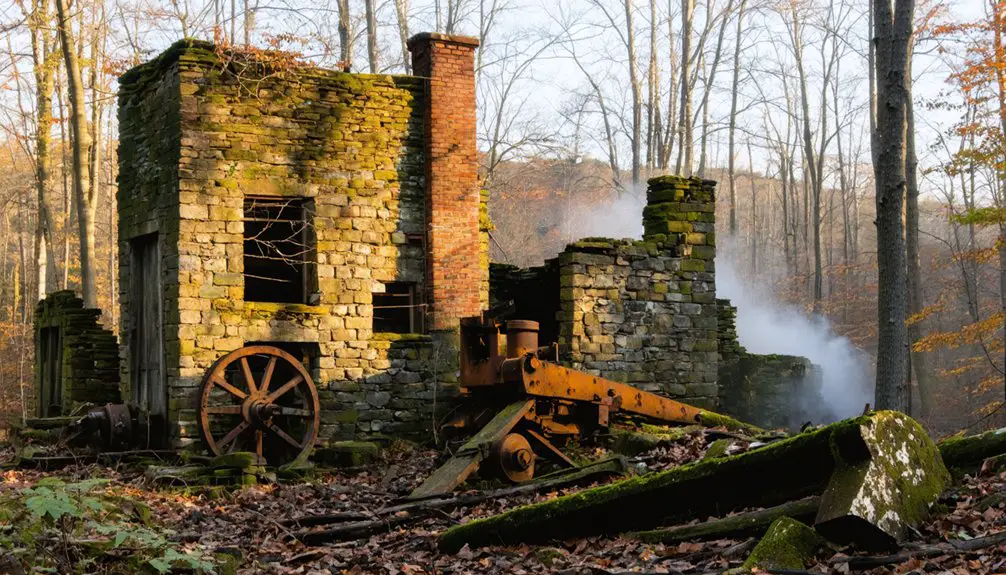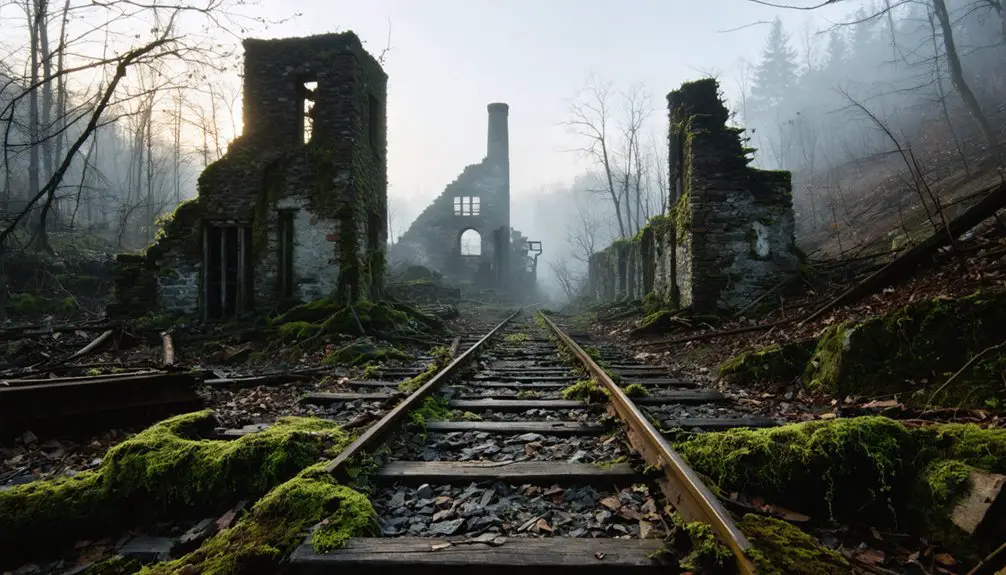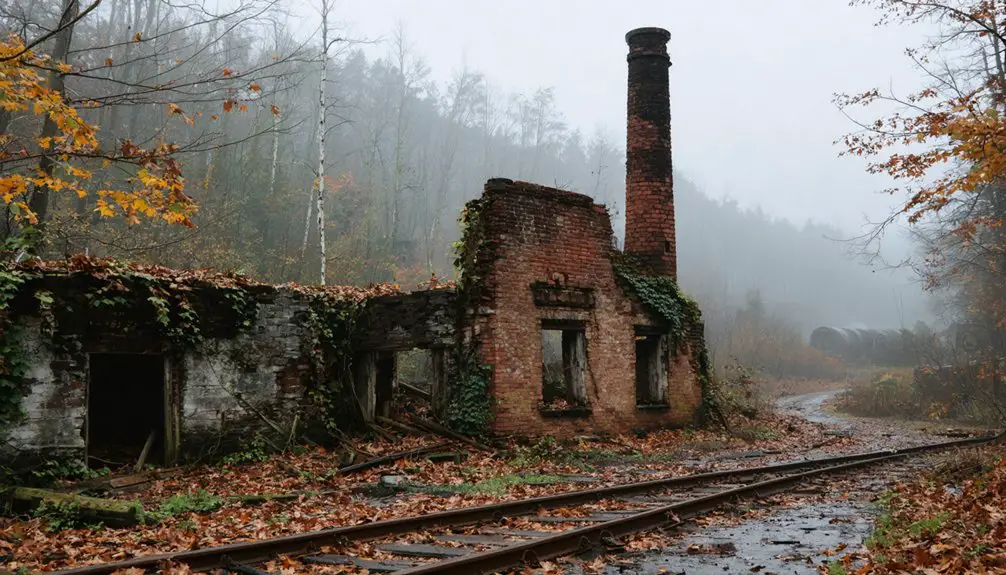You’ll find Fort Palmer’s haunting remains seven miles from Fort Ligonier, where a once-bustling coal mining town now lies abandoned. Originally established as a defensive stockade in 1777, it transformed into an industrial powerhouse when the Fort Palmer Coal and Coke Company began operations in 1907. The town declined after mining accidents, including the devastating 1910 Ernest Mine explosion. Today, crumbling coke ovens and dangerous sinkholes tell a complex story of frontier defense, industrial triumph, and ultimate abandonment.
Key Takeaways
- Fort Palmer transformed from a 1777 military stockade into a coal mining town before becoming abandoned due to industrial decline.
- The closure of Palmer Mine in 1957 and subsequent zinc smelting operations’ shutdown in 2014 led to widespread population loss.
- An ongoing underground mine fire, expected to burn for 250 years, creates hazardous conditions preventing town rehabilitation.
- Dangerous sinkholes, toxic gas emissions, and ground instability have forced authorities to restrict access to much of the area.
- Only stone foundations and deteriorating coke ovens remain as evidence of Fort Palmer’s military and industrial heritage.
Colonial Origins and Settlement History
While the Penn family initially controlled vast tracts between Bethlehem and Easton as hunting grounds in colonial times, squatters began occupying the area now known as Palmer Township by 1752.
These determined settlers cleared land and built homesteads without formal titles, defying proprietary control. When they petitioned for land purchase rights in 1759, provincial authorities denied their request, but the settlers persisted. Records show that Fort Palmer’s land was first legally conveyed to John Palmer in 1771.
Defying authority, resilient settlers carved out their own destiny, transforming untamed wilderness into homes despite lacking legal ownership.
Finally, in 1795, you’d have found these early pioneers legitimately purchasing their deeds at fixed prices.
Colonial settlement centered around landmarks like the Seipsville Hotel, which became essential for early governance and community gatherings. The hotel’s second floor stone barn served as the meeting place for township government operations.
Originally part of Forks Township, the area’s growing independence culminated in 1857 when Palmer Township gained its own status through court order.
Military Significance on the Frontier
As tensions escalated on the Pennsylvania frontier in 1777, Fort Palmer emerged as an essential defensive stockade seven miles from Fort Ligonier in Westmoreland County.
You’ll find it was part of Pennsylvania’s broader military strategy, which included more than a dozen frontier forts designed to protect settlers from Native American raids and British-allied forces.
The fort’s strategic location made it a critical refuge during frontier defense operations, as settlers would gather there when threats emerged across a 60-mile area.
During late 1777, the fort successfully repelled Indian attacks, proving its worth as a military bulwark.
As part of Pennsylvania’s unique approach to frontier defense, Fort Palmer helped secure crucial trade routes and settlement lines, marking the colony’s shift from unarmed settlement to armed protection of its western boundaries.
Rise of Coal Mining and Industrial Growth
Fort Palmer transformed from a frontier settlement into an industrial powerhouse when the Fort Palmer Coal and Coke Company established operations in 1907.
During peak production years, coal prices ranged between $3-4 per ton, making it a profitable venture for the company.
The Palmer Mine operated from 1908 until its closure in 1957, proving to be a major economic driver for the region during its five decades of activity.
You’ll find the company strategically positioned its coal mine and innovative Belgian-type coke ovens along the waterfront, maximizing transportation advantages for shipping.
The riverside location proved essential for the construction of extensive coal docks by the late 1920s, cementing Fort Palmer’s role in the region’s coal industry.
Mining Operations Begin 1880s
During the late 1880s, Pennsylvania’s industrial boom sparked extensive coal mining operations in the Fort Palmer region.
You’ll find early mining techniques were primitive and dangerous, with miners working in drift mines that lacked electric power and relied on risky open-flame lighting. These mines often extended through lengthy entry gangways, stretching up to 3,500 feet in a single year. The Consolidation Coal Company emerged as a dominant force in the region’s mining industry.
The region’s growth drew waves of immigrant labor between 1880 and 1920, particularly to Fayette and Westmoreland counties. Early mining efforts faced significant challenges until Jesse Fell’s discovery of using an iron grate successfully solved the problem of igniting anthracite coal in 1808.
Mining companies established controlled towns to house workers, who earned modest wages like $5.89 per day in 1917. Using chute and pillar methods, early operations remained largely unmechanized, while frequent accidents from falls and explosions highlighted the hazardous nature of this emerging industry.
Coal Transportation and Infrastructure
With the rise of coal mining in Fort Palmer, transportation infrastructure rapidly evolved to meet growing industrial demands.
You’ll find the town’s strategic river location proved essential, enabling construction of extensive coal docks in the late 1920s that revolutionized shipping efficiency. These docks let workers load high-grade metallurgical coal directly onto barges and vessels, connecting Fort Palmer’s output to broader markets.
The town’s transportation efficiency benefited from both rail and river options. While railroads had replaced canals as the dominant coal transport method by this time, Fort Palmer’s infrastructure investment in both modes gave operators flexibility during peak production. The loading facilities employed skilled workers called wheelers who moved loaded mine cars to the haulage roads for surface transportation. The Virginia Creeper railroad provided a crucial link between mining operations and regional distribution networks.
When rail lines became congested, river transport provided a cost-effective alternative, helping the town maintain steady coal shipments to steel mills and industrial centers.
Daily Life in Early Fort Palmer
Life in early Fort Palmer revolved around a close-knit community where wooden homes clustered together for protection and mutual support.
You’d experience a community reminiscent of Centralia’s early years, where Irish Catholic immigrants formed tight bonds and helped build the town’s social fabric. Your daily routines would’ve centered on essential tasks, from tending crops to preserving food in root cellars and smokehouses. You’d find yourself drawn to communal activities at the town’s social hubs – the tavern, church, and trading post. Much like the thriving mining economy that once powered Centralia, Fort Palmer’s local industry kept the community stable and self-sufficient.
You’d participate in frequent gatherings like barn raisings and harvest festivals, while evening hours brought neighbors together for storytelling and shared work.
You’d rely on local craftspeople for necessities, trading through a mix of barter and limited currency. When you needed supplies from larger towns, you’d face challenging journeys by horseback or wagon along rugged paths, especially during harsh Pennsylvania winters.
The Decline of a Mining Community

Fort Palmer’s decline began in earnest as fatal mining accidents, including the devastating Ernest Mine explosion of 1910, combined with plummeting coal prices to destabilize the local economy.
You’d find the town’s population steadily dropping through the early 20th century as miners and their families sought safer work elsewhere, particularly after West Virginia surpassed Pennsylvania in coal production by 1927.
The exodus accelerated when repeated disasters, volatile market conditions, and the inherent dangers of mining – from deadly gas buildups to flooding – made the prospect of staying in Fort Palmer increasingly untenable.
Economic Forces Behind Exodus
As Pennsylvania’s industrial landscape shifted in the early 20th century, Fort Palmer’s economic decline stemmed from multiple interconnected forces that devastated its mining-based economy.
You’ll find that the closure of zinc smelting operations by 2014 and the exodus of New Jersey Zinc Company dealt severe blows to local employment, while environmental contamination deterred new industrial investment.
The town’s economic migration accelerated as West Virginia overtook Pennsylvania in coal production by 1927.
You’d see how recurring unemployment cycles and catastrophic mining accidents eroded community resilience, pushing families to seek opportunities elsewhere.
Market instability in coal and coke industries, combined with intense regional competition, ultimately stripped Fort Palmer of its economic foundation.
The toxic legacy left behind made industrial redevelopment nearly impossible, sealing the town’s fate.
Coal Industry’s Fatal Impact
Mining’s deadly toll shaped Fort Palmer’s downfall more profoundly than mere economic shifts. You’d find miners facing death daily in poorly lit shafts and tunnels, where methane explosions and roof collapses claimed lives regularly.
Without proper safety regulations, the breast and pillar mining technique left workers vulnerable to catastrophic accidents.
The toxic legacy didn’t end with immediate fatalities. You can trace the community’s decline through generations of miner health issues, particularly black lung disease from constant coal dust exposure.
When breadwinners died or became too ill to work, families faced destitution. The mounting deaths and chronic illnesses fractured Fort Palmer’s social fabric, driving survivors to seek safer opportunities elsewhere.
Steam-powered ventilation systems failed to protect workers from deadly gases, while overcrowded company housing spread disease through remaining families.
Population Drain Accelerates
The population drain that devastated Fort Palmer emerged through predictable patterns you’d see in any dying coal town – young residents left first, followed by working families, until only the elderly remained.
Youth outmigration created a devastating ripple effect as locally educated students didn’t return after graduation, depriving the community of its next generation of leaders and workers.
Without new economic opportunities beyond the collapsing coal industry, you’d find Fort Palmer’s social fabric unraveling.
Local businesses shuttered their doors as spending power evaporated. Churches that once anchored the community saw their congregations dwindle.
Schools consolidated or closed entirely. The town’s infrastructure crumbled as the tax base shrank, making it even harder to attract new residents or industries to replace what was lost.
Architectural Heritage and Remaining Structures

Remnants of Fort Palmer’s architectural heritage paint a stark portrait of Pennsylvania frontier history, with only foundations and approximately 150 coke ovens surviving from this once-thriving settlement.
The architectural styles evolved from wooden stockades in the 1770s to industrial structures in the 19th century, showcasing the transformation from frontier defense to coal production.
You’ll find these key remaining features:
- Stone foundations marking the original townsite’s layout
- Refractory brick coke ovens demonstrating industrial-era construction techniques
- Historical materials ranging from local stone to heat-resistant masonry
The site’s structural footprint reveals both its defensive origins and industrial prosperity.
While no standing buildings remain from the original fort, the surviving coke ovens stand as evidence to Pennsylvania’s vital role in America’s industrial revolution.
Natural Surroundings and Geographic Features
Situated between two essential springs in Fairfield Township, Westmoreland County, Fort Palmer occupied a strategic position eight miles west of Greensburg and twenty-three miles east of Pittsburgh.
You’ll find the site nestled near Byerly Station on Forbes Road, about one and a half miles from Irwin and four miles south of Harrison City.
The fort’s location took advantage of natural water sources, with springs just three hundred yards south of the historic turnpike.
The terrain featured fertile soil that supported a thriving farming community, complete with crops and orchards.
The surrounding landscape included rolling Appalachian foothills, mixed deciduous forests, and well-drained agricultural land.
This combination of resources – from woodland materials to farmable soil – made the site ideal for early settlers seeking both sustenance and security.
Local Legends and Cultural Impact

Deep beneath Fort Palmer’s abandoned streets, an eternal mine fire burns, spawning numerous legends and supernatural tales that have shaped the town’s cultural legacy.
You’ll find ghost stories woven into the fabric of local lore, with reports of mysterious smoke and steam rising from the ground fueling tales of restless spirits.
- The underground inferno has inspired countless cultural myths, with locals describing it as a curse born from human greed and mining negligence.
- You’ll discover the town’s story immortalized in documentaries, literature, and music, serving as a haunting reminder of industrial disaster.
- Fort Palmer’s legacy lives on through tourist interest, though this brings tension between preservation and exploitation of its remaining structures.
The town stands as a powerful symbol of irreversible change, drawing those seeking to understand its complex history.
Preservation Efforts and Future Outlook
While preservation efforts have been launched to protect Fort Palmer’s remaining structures, the relentless underground mine fire poses insurmountable challenges to any meaningful restoration.
You’ll find preservation challenges at every turn, from dangerous sinkholes to toxic gas emissions across 400 acres of unstable ground. The authorities have installed warning signs and restricted access to protect you from these hazards.
Looking toward future sustainability, you won’t see traditional conservation methods working here. Instead, preservation focuses on documenting the town’s history through films, articles, and controlled tours.
Due to extreme conditions, Fort Palmer’s preservation relies on capturing its legacy through media documentation rather than physical restoration efforts.
With the underground fire expected to burn for another 250 years, Fort Palmer’s physical restoration isn’t feasible. The best you can expect is careful monitoring of the site and educational initiatives that keep the town’s story alive.
Frequently Asked Questions
Are There Any Dangerous Abandoned Mine Shafts Near Fort Palmer?
Dark holes dot the landscape where you’ll find numerous dangerous abandoned mine shafts near the area. While exact locations aren’t documented, Pennsylvania’s mining history means abandoned structures and mining hazards likely exist nearby.
What Valuable Artifacts Have Been Discovered at the Fort Palmer Site?
You’ll find significant artifacts spanning millennia: 9,800-year-old Palmer points, Indigenous skull effigies, French and Indian War cannonballs, colonial trade beads, and structural remains revealing rich historical context.
Can Visitors Legally Explore the Fort Palmer Ghost Town Ruins?
Like traversing a fog-covered trail, Fort Palmer’s legal status isn’t clear. You’ll need to verify land ownership and obtain proper permissions, as there aren’t established visitor guidelines or confirmed public access rights.
Were There Any Documented Paranormal Experiences at Fort Palmer?
You won’t find any verified ghost sightings or paranormal investigations at this location. Despite its eerie abandoned atmosphere, there’s no documented evidence of supernatural activity in historical or modern records.
Did Any Notable Historical Figures Ever Visit Fort Palmer?
You won’t find any documented evidence of famous visitors or historical significance through notable figures at this location. Records don’t show any prominent personalities ever visiting the settlement.
References
- https://pabucketlist.com/the-rise-and-fall-of-centralia-pas-toxic-ghost-town/
- https://www.youtube.com/watch?v=Qj5LjacccJ0
- https://en.wikipedia.org/wiki/Centralia
- https://en.wikipedia.org/wiki/List_of_ghost_towns_in_Pennsylvania
- https://www.wikiwand.com/en/articles/List_of_ghost_towns_in_Pennsylvania
- https://palmertwp.com/history.html
- http://www.usgwarchives.net/pa/1pa/1picts/frontierforts/ff31.html
- https://www.pa-roots.com/westmoreland/historyproject/vol1/chap7a.html
- https://libsysdigi.library.illinois.edu/OCA/Books2012-06/fortsonpennsylva00hunt/fortsonpennsylva00hunt.pdf
- https://www.northamericanforts.com/East/pa-west.html



